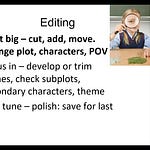Video Transcription: I thought I was done talking about fast starts for now, but I just reread A Wizard's Guide to Defensive Baking, by T. Kingfisher, and I thought this was such a great example of getting off to a fast start that it would be helpful to take a look at it.
It opens with: There was a dead girl in my aunt's bakery.
Right away, something dramatic happening grabs the reader's attention. We don't know a ton of information about where we are yet, but we do know we're in a bakery and we know there's a dead girl. And we know that the viewpoint character is speaking in first person.
Then: I let out an undignified yelp and backed up a step, then another until I ran into the bakery door. We kept the door open most of the time because the big ovens get swelteringly hot otherwise, but it was four in the morning and nothing was warmed up yet.
A little bit of action, a little bit of setting detail. She's obviously startled by the dead girl, so we're learning that she must have just discovered the body.
Then: I could tell right away that she was dead. I haven't seen a lot of dead bodies in my life. I'm only 14 and baking is not exactly a high mortality profession.
Right there, it's a nice way of establishing the character's age without having to just say it. It makes sense in this context that that's what she's thinking about. And we learned that she works in the bakery.
Then: But the red stuff oozing out from under her head definitely wasn't a raspberry filling.
A little bit of descriptive detail in the voice of a young baker.
Then: And she was lying at an awkward angle that nobody would choose to sleep in, even assuming they'd break into a bakery to take a nap in the first place. My stomach made an awful clenching, like somebody had grabbed it and squeezed hard, and I clapped both hands over my mouth to keep from getting sick. There was already enough of a mess to clean up without adding my secondhand breakfast to it.
So physical details to capture that emotion, but also show a little bit about her character, that even though she's horrified and feeling sick, she has the presence of mind to not want to make a mess in the bakery.
Then: The worst thing I've ever seen in the kitchen was the occasional rat. Don't judge us.
You can't keep rats out in this city. And we're as clean an establishment as you'll ever find.
And the zombie frog that crawled out of the canals.
Okay, now we're introducing a fantasy or paranormal aspect. This is a world that has zombie frogs. We're also learning that it's in a city, that it's probably not the cleanest city, although most big cities even today have rats. It has canals. We're getting some setting details to establish where we are, in the context of what's happening in this moment, instead of starting with a lot of description about the place.
Then: Poor things had been downstream of the cathedral, and sometimes they dump the holy water a little recklessly, and you get a plague of undead frogs and newts and whatnot. The crawfish are the worst. You can get the frogs with a broom, but you have to call a priest for a zombie crawfish.
A little touch of humor, more world building, that some of these surprising things are fairly normal here.
Then: But I would have preferred any number of zombie frogs to a corpse. I have to get Aunt Tabitha.
Now she has a specific immediate goal. And this is just within the first couple of pages. That really grabbed my attention and was a good example of how you can drop the reader into a scene where things are happening. even if it's an unfamiliar fantasy or historical world, you can build the setting and the character through what's happening.
Now, I want to note that when I got to the end of the book and looked at the author's note, Ursula Vernon is a well-published author who started self-publishing her quirkier things under the name T. Kingfisher. This book had made the rounds for over a decade. Her agent liked it. A lot of editors liked it, but they weren't sure what to do with it. That's not because of that opening, but because it's sort of a horror children's book. It's a little hard to place, although it is a great read and I think has been fairly popular.
But one of the editorial feedback pieces she got from at least one person was: Do you really have to start with a dead body? Maybe you could lead into that.
It’s a matter of taste, whether you want to start with something quite that dramatic or give a little more setting or character or whatever first. But look at this and see what works, in your opinion,
what feels like it could fit your style.
You can also go through other novels and use this kind of analysis to help you figure out what works, what you like, and so forth.
That's it for this week, as I’m seeing family for the holiday weekend. I just wanted to share something I was thinking about this week.













Share this post